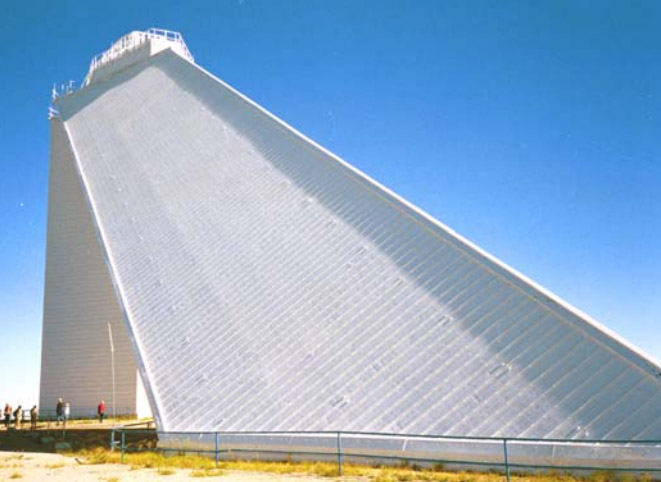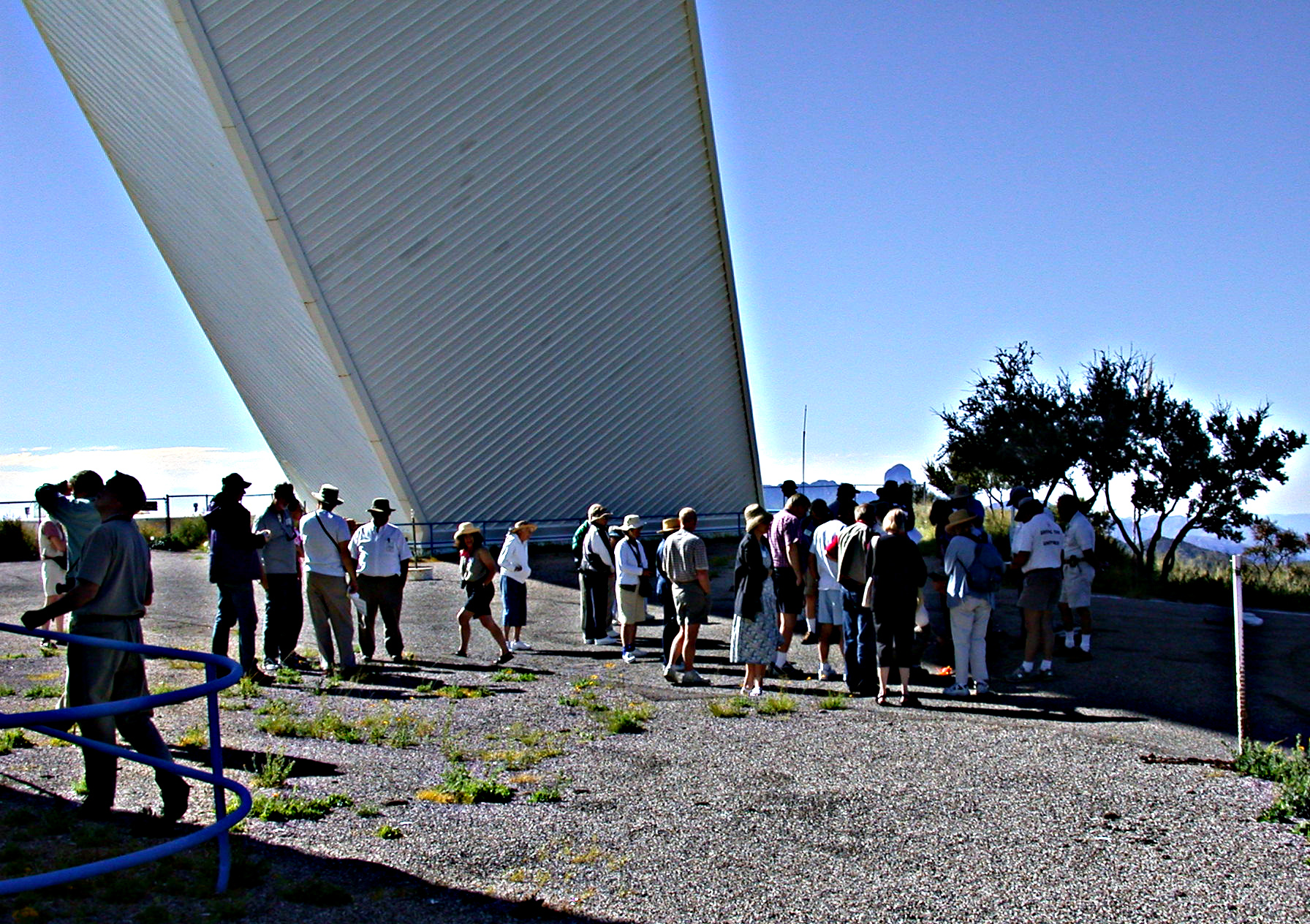- Details
- Hits: 9671
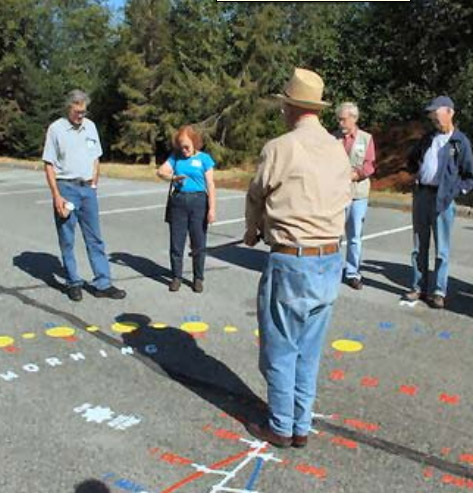 Art meets science: John Carmichael held a workshop on DeltaCAD, a flexible computer aided design program for designing sundials and later in the conference with “Some New Sundials I” showed the result of such designs in beautiful stain glass sundials. From the history domain, Fred Sawyer told the story of Captain Sturmy, a 17th century mariner and author of “Gnomonical Scales,” now part of the Shadow Catchers series. Len Berggren discussed the sundials of Geminos of Rhodes in his text “Introduction to the Phenomena,” written about the first century BCE. Chuck Nafziger showed his light concentration sundial with Braille markings to show time-telling to the vision impaired, and Professor Woody Sullivan displayed a prototype of the One-World-Two-Suns Mars sundial. On the pavement of the parking lot, Brian Albinson drew out the split-analemma analemmatic sundial. See these sundials and more … download the PDF.
Art meets science: John Carmichael held a workshop on DeltaCAD, a flexible computer aided design program for designing sundials and later in the conference with “Some New Sundials I” showed the result of such designs in beautiful stain glass sundials. From the history domain, Fred Sawyer told the story of Captain Sturmy, a 17th century mariner and author of “Gnomonical Scales,” now part of the Shadow Catchers series. Len Berggren discussed the sundials of Geminos of Rhodes in his text “Introduction to the Phenomena,” written about the first century BCE. Chuck Nafziger showed his light concentration sundial with Braille markings to show time-telling to the vision impaired, and Professor Woody Sullivan displayed a prototype of the One-World-Two-Suns Mars sundial. On the pavement of the parking lot, Brian Albinson drew out the split-analemma analemmatic sundial. See these sundials and more … download the PDF.
- Details
- Hits: 9958
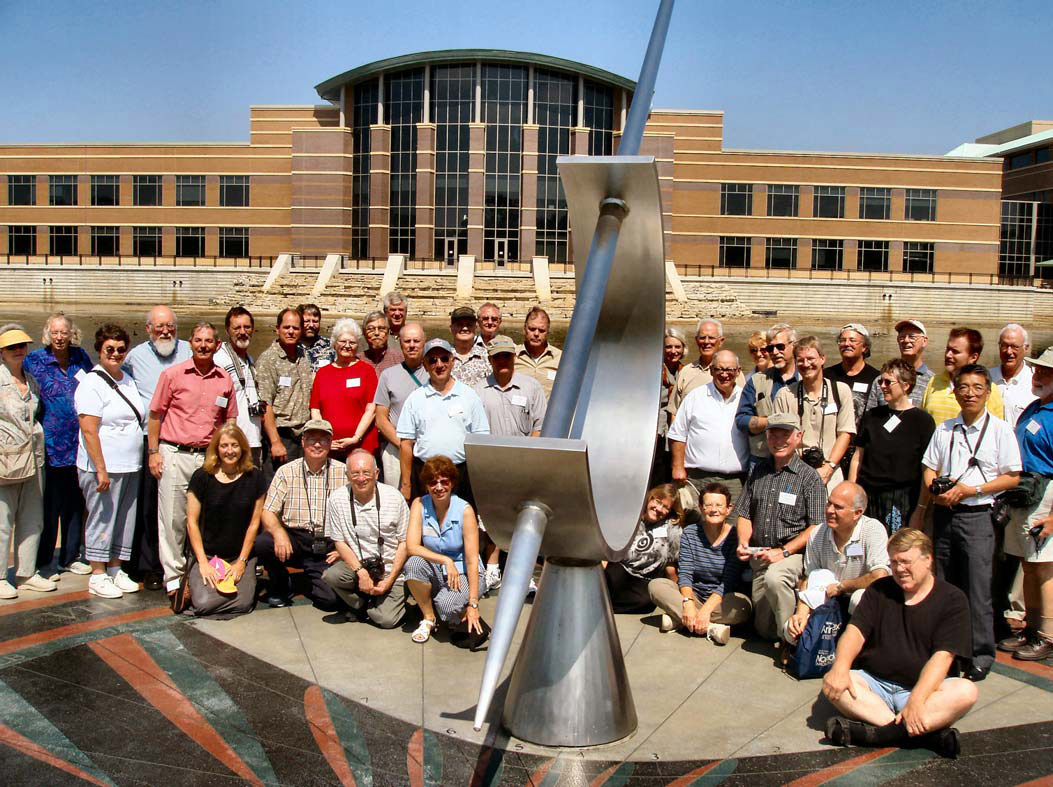 This conference contrasted the old and the new. Steve Luecking presented “Rope Geometry”, an outdoor exercise to draw an ellipse on the ground and draw a horizontal dial using only a knotted cord and stakes in the fashion of ancient Egyptian “rope pullers” (civil engineers). When the conferees visited the Museum of Science and Industry, they were able to see a collection of dials, including a fine example of a first century AD dial, a slight variant of a hemisphaerium. Klau Eichholz talked about Fr. Franz Xaver Josef Bovius and the restoration of his 1716 dial at Solnhofen. On the modern fron, Mike Shaw led the group carefully through the steps of understanding and creating the ingenious Universal Diallist’s Companion. By special arrangement, Fred Sawyer distributed copies of this very useful device to everyone in attendance. Fred then introduced another new dial of his devising, the Hectemoros Dial. Tony Moss discussed two power point presentations “Using and Understanding Sundials” and “Concepts for Students of Sundialling”. A highlight of the conference was the announcement that the North American Sundial Society had been asked to be technical advisor on sun shadows for an episode of the television series “NUMB3RS.” Plus many other presentations by Larry McDavid, Don Petrie, Roger Bailey and a workshop on 3D CAD by SteveLuecking.
This conference contrasted the old and the new. Steve Luecking presented “Rope Geometry”, an outdoor exercise to draw an ellipse on the ground and draw a horizontal dial using only a knotted cord and stakes in the fashion of ancient Egyptian “rope pullers” (civil engineers). When the conferees visited the Museum of Science and Industry, they were able to see a collection of dials, including a fine example of a first century AD dial, a slight variant of a hemisphaerium. Klau Eichholz talked about Fr. Franz Xaver Josef Bovius and the restoration of his 1716 dial at Solnhofen. On the modern fron, Mike Shaw led the group carefully through the steps of understanding and creating the ingenious Universal Diallist’s Companion. By special arrangement, Fred Sawyer distributed copies of this very useful device to everyone in attendance. Fred then introduced another new dial of his devising, the Hectemoros Dial. Tony Moss discussed two power point presentations “Using and Understanding Sundials” and “Concepts for Students of Sundialling”. A highlight of the conference was the announcement that the North American Sundial Society had been asked to be technical advisor on sun shadows for an episode of the television series “NUMB3RS.” Plus many other presentations by Larry McDavid, Don Petrie, Roger Bailey and a workshop on 3D CAD by SteveLuecking.
- Details
- Hits: 13464
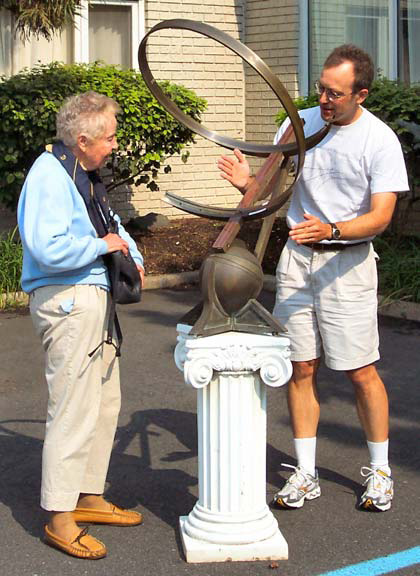 At Tenafly, New Jersey NASS conferees once again to discuss sundials and sundial making. Larry McDavid began the conference with “Sundials: Prehistory to the Digital Age” intended as an instructional power point that can be given to a wide spectrum of adult audiences. A companion presentation, “Beauty in Dialing” is also released for educational use. Bob Kellogg discussed construction and alignment of the Freedom High School 9-11 memorial Dial. Bob Terwilliger “in a blaze of entertaining wizardry” described Bion’s 17th and 18th century techniques for dial construction usin his laser trigon “sciatorium.” Bob showed how his precision instrument that can “draw a sundial on a Buick” also can design a dial on his garden hot-tub. Steve Luecking demonstrated programs for deriving hour lines and day lines from shadow planes and other CAD techniques. Plus many more interesting presentations by Bill Gottesman, Robert Adzema, Martin Jenkins, John Carmaichael, and Sara Schechner.
At Tenafly, New Jersey NASS conferees once again to discuss sundials and sundial making. Larry McDavid began the conference with “Sundials: Prehistory to the Digital Age” intended as an instructional power point that can be given to a wide spectrum of adult audiences. A companion presentation, “Beauty in Dialing” is also released for educational use. Bob Kellogg discussed construction and alignment of the Freedom High School 9-11 memorial Dial. Bob Terwilliger “in a blaze of entertaining wizardry” described Bion’s 17th and 18th century techniques for dial construction usin his laser trigon “sciatorium.” Bob showed how his precision instrument that can “draw a sundial on a Buick” also can design a dial on his garden hot-tub. Steve Luecking demonstrated programs for deriving hour lines and day lines from shadow planes and other CAD techniques. Plus many more interesting presentations by Bill Gottesman, Robert Adzema, Martin Jenkins, John Carmaichael, and Sara Schechner.
- Details
- Hits: 9531
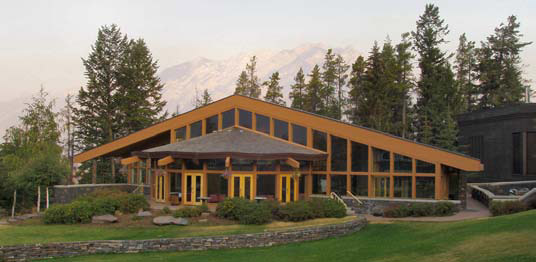 Thirty Nine NASS members met in the beauty of the Canadian Rockies at the Banff Conference Center. Talks began with Roger Bailey explaining his approach to “Designing a Sundial from Scratch” using basic trigonometric formulas. Then Fred Sawyer described the 19th century French engineer Charles-Nicolas Peaucellier who published a type of dial using only straight lines. Among other presenters was Tom Kreyche with “Projections of the Sphere for Universal Astrolabes. The center of attention came when Paul Nibley presented a variety of sundials with alarms. Everyone was delighted to watch his noonday cannon remind us of the sun on the meridian. Also demonstrated was a butterfly sun alarm that spread its wings with a chime, powered by solar cells. Tony Moss, UK dialist, discussed his efforts toward working with stainless steel. Roger Bailey discussed astro-archeology from the Stone Age the the Mayans and the Renaissance. Later, Dr. Gordon Freeman, Albertan scholar, presented his research on the Majorville Medicine Wheel. These are only some of the fine papers presented.
Thirty Nine NASS members met in the beauty of the Canadian Rockies at the Banff Conference Center. Talks began with Roger Bailey explaining his approach to “Designing a Sundial from Scratch” using basic trigonometric formulas. Then Fred Sawyer described the 19th century French engineer Charles-Nicolas Peaucellier who published a type of dial using only straight lines. Among other presenters was Tom Kreyche with “Projections of the Sphere for Universal Astrolabes. The center of attention came when Paul Nibley presented a variety of sundials with alarms. Everyone was delighted to watch his noonday cannon remind us of the sun on the meridian. Also demonstrated was a butterfly sun alarm that spread its wings with a chime, powered by solar cells. Tony Moss, UK dialist, discussed his efforts toward working with stainless steel. Roger Bailey discussed astro-archeology from the Stone Age the the Mayans and the Renaissance. Later, Dr. Gordon Freeman, Albertan scholar, presented his research on the Majorville Medicine Wheel. These are only some of the fine papers presented.
- Details
- Hits: 9537
|
McMath-Pierce Solar Telescope at Kitt Peak
NASS Attendees at Solar Telescope |
The skies were clear for the NASS conference in Tuscon, Az. Conferee speakers received a replica of the “Fugio” cent, America’s first coin issued in 1787. This coin was designed by Benjamin Franklin and shows a sundial with the motto “Fugio” meaning “Time flies”. Continuing the historical theme, Len Breggren discussed the history of sundials to 200 BCE and the work of the Greek geometer Diocles, who described the earliest Greek sundial, a hemispherical mirror that indicated the hour of the day from burning a trace. Fred Sawyer discussed the overlap of Dialing and Cartography. John Schilke’s presentation "Oh, East Is East and West is West" was a note on the Prime Vertical, that great circle which passes through the zenith and nadir and the east and west points of the horizon. The Prime Vertical is thus orthogonal to the meridian and to the horizon. Bill Walton presented “Pinholes and Shadow Sharpening” and Bill Gottesman presented a method for measuring wall declination using a carpenter’s square. Saturday’s sundial tour started at the Kitt Peak National Observatory, home of the world’s largest collection of optical telescopes (in 2002) and John Carmichael discussed how one might turn the McMath-Pierce Solar Telescope into a sundial.
Carl Haskett showed off his well crafted patented SunClock design, a pair of semi-cylindrical polar dials adjustable for latitude, longitude and equation of time. When set for the location, the SunClock will show clock time of day and the approximate day of the month. Claude Hartman demonstrated a model of his award winning sundial structure that incorporates ten separate sundials. These dials can be read on the walls and inside the stained glass structure. Bill Walton displayed an analemmatic “Sun Compass” and an interesting Pelekinon double axis sundial.
(Clockwise from upper left) Bill Gottseman demonstrates his Sawyer Equant Dial; Dudley Warner and Len Berggren discuss Claude Hartman's model of his dial structure; Walton's Sun Compass and Pelekinon double axis sundial; details of Stumpges equatorial dial with the motto "Perceive Your Place in Time and Space".
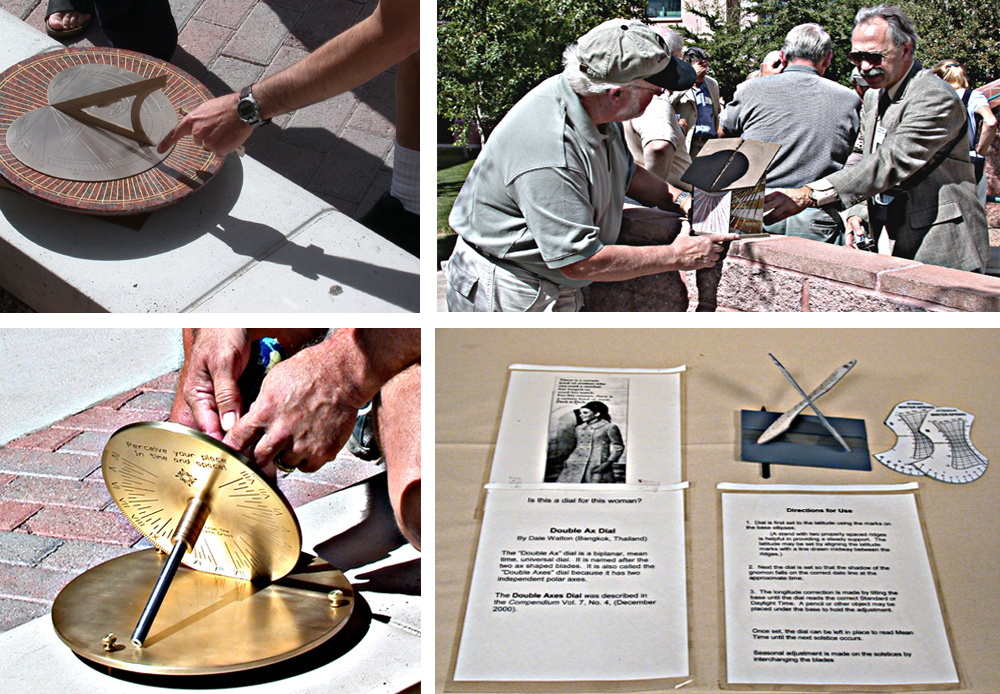
- Details
- Hits: 9589
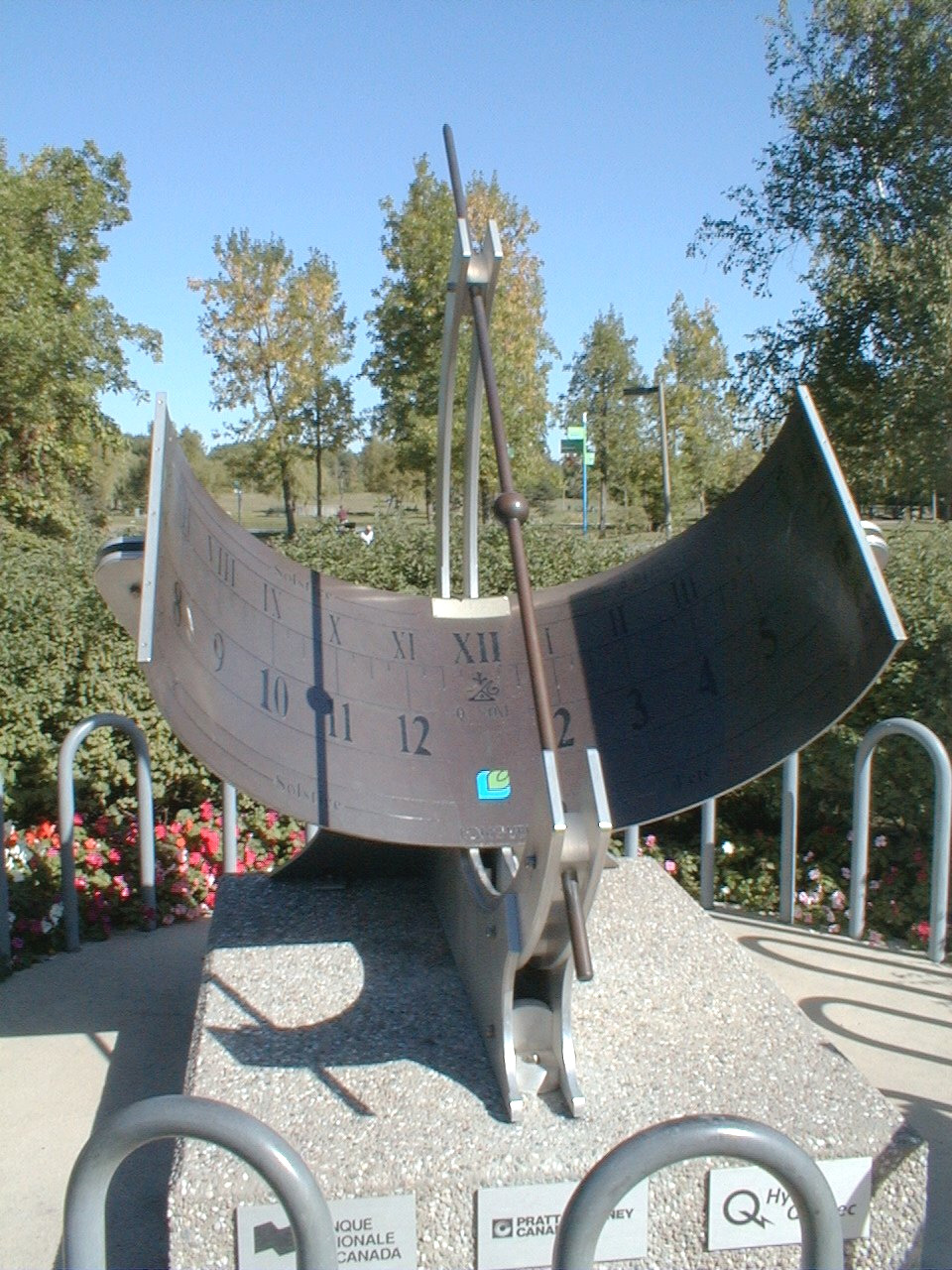 Faced with the turmoil of September 11th, many NASS members were unable to attend the conference. André Bochard began by giving description of sundials in the Stewart Museum collection, visited by the conferees the following day. Fred Sawyer described the beginning of the Shadow Catcher series, a set of digital reproductions of historical dialing books. Then, a number of interesting sundials were described, including the Sunmaster universal ring dial, an update on digital sundials, and a new type of horizontal dial from Fred Sawyer. André Bochard gave the conferees information on the formation and operation of Commission des Cadrans Solaire de Québec, the society devoted to French Canadian sundialing. Bill Gottesman spoke about his “Mathematical Expedition to the North Pole”, illustrating the concepts by juggling a bowling ball. The sundial tour included the Steward Museum and outdoor equatorials seen on a sunny day at the Parc régional de Longueuil and the marina de Boucherville.
Faced with the turmoil of September 11th, many NASS members were unable to attend the conference. André Bochard began by giving description of sundials in the Stewart Museum collection, visited by the conferees the following day. Fred Sawyer described the beginning of the Shadow Catcher series, a set of digital reproductions of historical dialing books. Then, a number of interesting sundials were described, including the Sunmaster universal ring dial, an update on digital sundials, and a new type of horizontal dial from Fred Sawyer. André Bochard gave the conferees information on the formation and operation of Commission des Cadrans Solaire de Québec, the society devoted to French Canadian sundialing. Bill Gottesman spoke about his “Mathematical Expedition to the North Pole”, illustrating the concepts by juggling a bowling ball. The sundial tour included the Steward Museum and outdoor equatorials seen on a sunny day at the Parc régional de Longueuil and the marina de Boucherville.
See these dials and much more in the PDF download!
- Details
- Hits: 9902
 Ron Anthony, Carl Trost and Mark Gingrich organized the 2000 NASS conference in San Francisco. A wide variety of sundial papers were presented, including Carl Trost’s description of the 1913 opening of the Ingleside Terrace sundial with a 28-foot gnomon, Robert Kellogg’s description of the “Amazing Maize Maze” the largest “organic” sundial, and educational insights by Mac Oglesby and Paul Lapp who reminded the conferees that “Toves don’t do Trig”. Download the PDF to read about the other sundial talks and discover the Azimeter and Sawyer Equant dials are all about. The sundial tour included a visit to the Heliodon at the Energy Center of Pacific Gas & Electric Company, and a tour through San Francisco and Berkely to see a number of dials including the Entrada Court horizontal dial at Ingleside Terracethe large horizontal dial at Hunter’s Ridge and the Navigator’s Sundial on the back of a tortoise in Golden Gate Park, and the Sunstone Alignment stones at the Park and at Lawrence Hall of Science in Berkeley.
Ron Anthony, Carl Trost and Mark Gingrich organized the 2000 NASS conference in San Francisco. A wide variety of sundial papers were presented, including Carl Trost’s description of the 1913 opening of the Ingleside Terrace sundial with a 28-foot gnomon, Robert Kellogg’s description of the “Amazing Maize Maze” the largest “organic” sundial, and educational insights by Mac Oglesby and Paul Lapp who reminded the conferees that “Toves don’t do Trig”. Download the PDF to read about the other sundial talks and discover the Azimeter and Sawyer Equant dials are all about. The sundial tour included a visit to the Heliodon at the Energy Center of Pacific Gas & Electric Company, and a tour through San Francisco and Berkely to see a number of dials including the Entrada Court horizontal dial at Ingleside Terracethe large horizontal dial at Hunter’s Ridge and the Navigator’s Sundial on the back of a tortoise in Golden Gate Park, and the Sunstone Alignment stones at the Park and at Lawrence Hall of Science in Berkeley.
- Details
- Hits: 8571
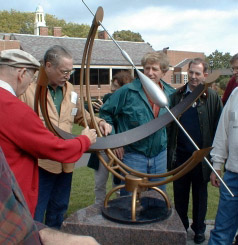 This year’s NASS conference was held in Hartford, CT with 50 attendees. There were many presenters from sculptor and sundial designer Robert Adzema to Mike Shaw, one of four attendees from the UK. There were many interesting dials on display, including Fritz Stumpges “Solar Flair” dial, Larry Bohlayer’s “Sun Vial, Bill Gottesman’s Spiral Sundial, Mac Oglesby’s shadow plane dial, Mayall’s Cube dial at CIGNA, Waugh’s pillar dial at University of Connecticut, and Judy Young’s “Sunwheel” stone alignment circle at University of Massachusetts in Amherst. Tom Kreyche presented a paper describing his computer program to update and expand NASS’s Dialist’s Companion software while Sara Schechner discussed the interrelation of sundials, time and Christianity, drawing upon many European cathedrals that served as giant meridian sundials. As with a number of previous conferences, it rained or was sunless for much of the Saturday sundial tour.
This year’s NASS conference was held in Hartford, CT with 50 attendees. There were many presenters from sculptor and sundial designer Robert Adzema to Mike Shaw, one of four attendees from the UK. There were many interesting dials on display, including Fritz Stumpges “Solar Flair” dial, Larry Bohlayer’s “Sun Vial, Bill Gottesman’s Spiral Sundial, Mac Oglesby’s shadow plane dial, Mayall’s Cube dial at CIGNA, Waugh’s pillar dial at University of Connecticut, and Judy Young’s “Sunwheel” stone alignment circle at University of Massachusetts in Amherst. Tom Kreyche presented a paper describing his computer program to update and expand NASS’s Dialist’s Companion software while Sara Schechner discussed the interrelation of sundials, time and Christianity, drawing upon many European cathedrals that served as giant meridian sundials. As with a number of previous conferences, it rained or was sunless for much of the Saturday sundial tour.
- Details
- Hits: 9889
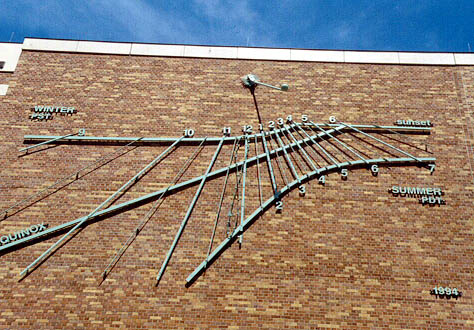 The attached PDF file begins “For the second year in a row, the Sun shone brightly on the annual NASS conference,” even though it was held at the University of Washington in Seattle. A large number of sundial related displays, outdoor demonstrations, and a local tour of Seattle area sundials provided “hands-on” experience for the conferees. Woody Sullivan, conference host, described the “hands-on” experience of designing and building the large vertical dial on the Physics and Science building. Len Berggren presented history of gnomonics in medieval Islam, pointing out that the time of afternoon prayer is defined in terms of gnomon shadow length. The Seattle tour of sundials included the analemmatic sundial in Gasworks Park, dials at Billings Middle School, and the Webster Park Equatorial Sundial among many others. See what you missed, and download the PDF for all the details.
The attached PDF file begins “For the second year in a row, the Sun shone brightly on the annual NASS conference,” even though it was held at the University of Washington in Seattle. A large number of sundial related displays, outdoor demonstrations, and a local tour of Seattle area sundials provided “hands-on” experience for the conferees. Woody Sullivan, conference host, described the “hands-on” experience of designing and building the large vertical dial on the Physics and Science building. Len Berggren presented history of gnomonics in medieval Islam, pointing out that the time of afternoon prayer is defined in terms of gnomon shadow length. The Seattle tour of sundials included the analemmatic sundial in Gasworks Park, dials at Billings Middle School, and the Webster Park Equatorial Sundial among many others. See what you missed, and download the PDF for all the details.

